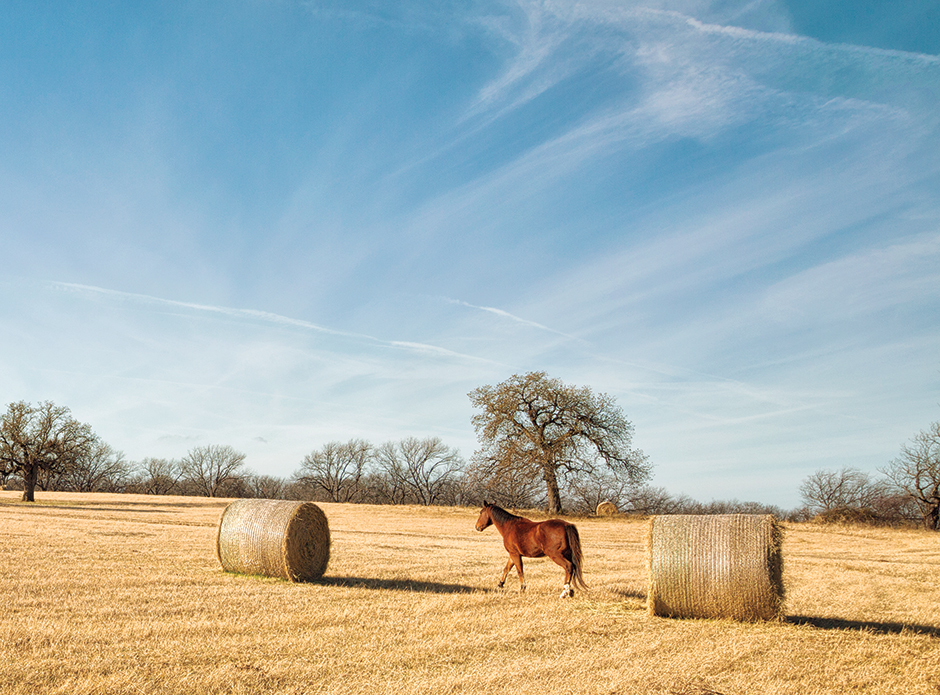
Though a North Texas native, I somehow never considered the Red River Valley a great getaway option—until recently. Tips from savvy friends piqued my curiosity about the stretch of landscape between Gainesville and Wichita Falls.
Find more on lodging, restaurants, wineries, and other Red River Valley attractions.
Red River Road Trip
Saint Jo:
Davis & Blevins Gallery, 108 S. Main St., 940/995-2786.
The Lazy Heart Grill, 101 S. Main St., 940/995-2967.
Arché vineyard and winery, 228 Wagner Road, 214/536-6330.
Blue Ostrich Winery & Vineyard, 5611 FM 2382, 940/995-3100.
Blue Ostrich Guesthouse, 940/995-3100. Stay in a four-bedroom home with front and back porches, swimming pool, and sweeping views.
Ancient Ovens, 857 S. Childress Road, 940/366-4255.
Texas Kings Hotel, 104 S. Broad St., 940/995-2565. Find five spacious, individually decorated rooms in a vintage building on the town square.
Nocona:
Fenoglio Station BBQ, 510 West US 82, 940/825-3843.
The Boot Store, 101 Clay St., 940/825-3047.
Nokona American Ballgloves, 105 Clay St., 800/433-0957.
Horton Classic Car Museum, 115 W. Walnut St., 940/825-1022.
Red River Station Inn, 219 Clay St., 940/825-3107.
Veranda Inn, 1523 East US 82, 940/825-5111. The property offers RV camping in addition to 29 modern motel-style rooms.
Once my husband and I packed a bag and hit the highway, we quickly found makings for the perfect road trip, one populated with intriguing discoveries in a pair of tiny towns imbued with sizable doses of Chisholm Trail history. Best of all, we reveled in the quiet of lonely drives on lovely two-lane roads that climb and fall with the ridges following the famous river. In spite of its seeming remoteness, the Red River Valley reveals jewels easily mined simply by wandering along well-worn sidewalks and cruising raw, rewarding terrain. Here’s how our weekend adventure unfolded.’
We reached the town of Saint Jo, a community of about 1,000 residents in Montague County, less than 90 minutes after leaving Fort Worth. And because I’m a cowgirl at heart—my cowboy boots are my favorite footwear and I’ve rarely seen a horse I didn’t yearn to ride—our first mission in Saint Jo was to find artist Donna Howell-Sickles. A descendent of Saint Jo founder Joseph Howell, Donna is famous for her mixed-media artworks depicting contemporary cowgirls and Western wildlife, thus earning her a spot in Fort Worth’s National Cowgirl Museum and Hall of Fame.
Fortunately, the artist is ever-present in the elegant, expansive Davis & Blevins Gallery she and her husband, John, opened on the town square in 2010. We found her greeting guests with the grace that emanates from her art, so we first amused ourselves by perusing gifts, including beaded necklaces, leather bracelets, silver-and-turquoise trays, and handmade scarves in the first of her three storefronts. The two adjacent gallery spaces display Donna’s original works, as well as sculpture, paintings, and drawings by more than 20 colleagues. We were struck by the extraordinary quality of work, which reminded us of the kind you’d find in galleries in Santa Fe, Aspen, and Scottsdale.
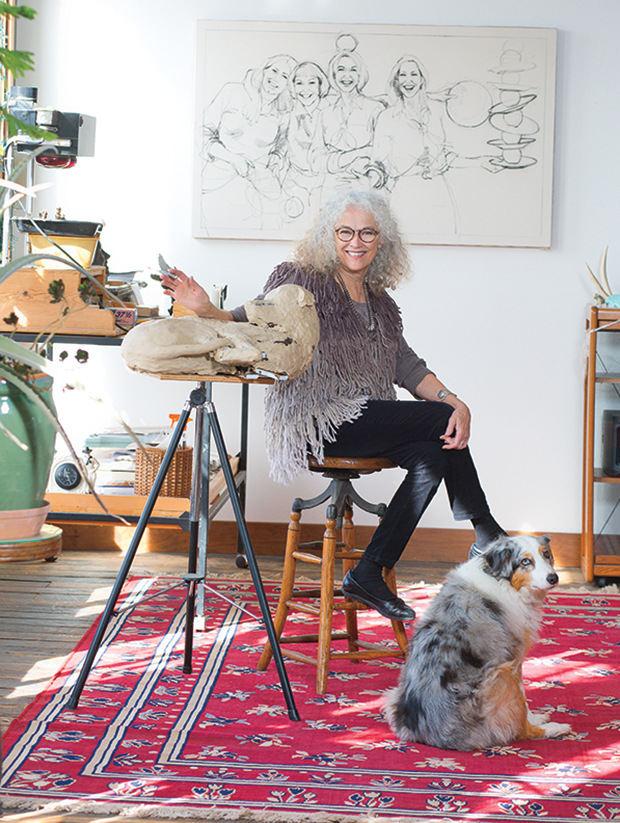
Artist Donna Howell-Sickles at her Saint Jo studio.
Once Donna learned that my husband, Marshall, is also an artist, she offered to give us a tour of her upstairs studio. Not only did we meet her very sweet Australian shepherd, Rubie, we were able to see various easels revealing her creative process with charcoal, pastel, and acrylic. When I asked her if the cowgirls are women she knows, her brown eyes twinkled as she said, “I always know them in spirit.”
Eventually, we continued down Main Street to see more of Saint Jo, poking our heads past the swinging wooden doors of the Stonewall Saloon Museum, a wonderfully creaky 1873 stone building that has housed various businesses over the years, including bars, a bank, and allegedly a brothel. After fortifying ourselves with a chicken-fried steak at the adjacent Lazy Heart Grill, a friendly spot with a collection of old boots atop a piano, we moseyed on to look around other shops. My favorite, a boutique called Panache, enticed me with a selection of dishtowels, heavy wine goblets, scented candles, local olive oils, and a brass bracelet bearing the shape of Texas, embossed with the word “Howdy.”
With much ground yet to cover, we made our way 13 miles northwest along US 82 to the town of Nocona. Just before we pulled into the vintage downtown, we took a moment to photograph the abandoned, art deco-era Nocona Boot Factory building. The leather goods industry, and particularly the cowboy boot manufacturing business, put the town on the map in the 1880s during the cattle-drive era and made it relevant long after the oil boom of the 1920s and 1930s ran its course.
Nocona boots are no longer made in Texas, but the company’s boot-making legacy lives on, thanks in part to the Boot Store on Clay Street, the main thoroughfare in downtown Nocona. Occupying the 1925 brick building where Nocona got its start, the retail operation brims with goods made by two local boot companies, Fenoglio Boot Company and James Montague Boots. The selection of boots for men, women, and children runs the gamut from classic Western styles to wildly colorful, modern designs. Along with footwear, the shop also carries accessories, such as hats, necklaces, scarves, and other Western-inspired clothing.
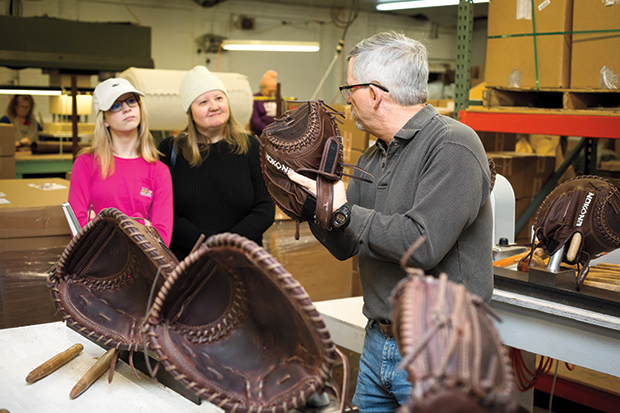
Nokona American Ballgroves offers tours on Monday and Friday.
The entire stretch of Clay Street, we found, offers varied portals to history. We realized right away that we would need the better part of a day to fully explore the Horton Classic Car Museum, a collection so large that it spreads throughout several downtown buildings. The cool rides, some 140 in all, each in pristine condition, belong to Pete and Barbara Horton, philanthropic residents who’ve helped Nocona restore several structures downtown. The majority of their beautiful American vintage and muscle cars (including more than 40 Corvettes dating to the 1950s) reside in a renovated Ford dealership festooned with enough neon and other flashy lighting to rival the Las Vegas Strip.
We enjoyed learning more history as we stopped to explore the Red River Station Inn. Owners Bob and Kristal Ferguson invested lots of time and effort into renovating the building, using found items like old windmills, metal awnings, and aged shiplap boards to add personality and warmth to the interior. Best of all, the Fergusons share a different story from Montague County heritage in each of the inn’s 10 rooms; my favorites were the Mose Johnson Room, with a chicken motif that relates to a local poultry ranch, and the Amon G. Carter Room, honoring the founder of the Fort Worth Star-Telegram, who grew up in Nocona.
The inn also makes guests feel welcome with its upstairs lounge area, which doubles as a breakfast room and afternoon happy-hour spot. Before moving on, we lingered in the inn’s gift shop, admiring locally made woodcraft items, such as hand-turned bowls, boxes, and ice cream scoops with beautiful wooden handles.
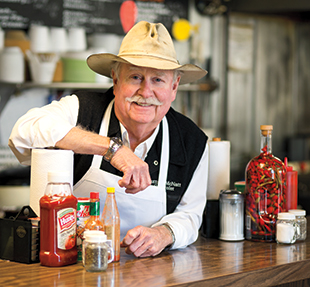
Robert Fenoglio serves as head storyteller at Fenoglio Station BBQ.
Over breakfast burritos one morning at a bustling café called Fenoglio Station, we enjoyed a lively chat with the proprietor, Nocona Mayor Robert Fenoglio, whose ease in pouring coffee and greeting regular clientele while directing his friendly staff matches his talent for reminiscing about his family’s history. We particularly enjoyed looking at dozens of framed family photos hanging on the walls next to rusted signs and license plates.
Balancing our time investigating the towns, we allowed requisite hours to wander the northern reaches of Montague and Cooke counties, taking in the unexpected topography. Setting out for a ghost town called Spanish Fort, which lies just a few hundred yards south of the Red River, we marveled at the vastness of the green, hilly countryside populated by trees, farms, and assorted old and new pump jacks—and little else. In Spanish Fort, we found what must be a forgotten cemetery, with exquisitely crafted headstones noting the lives of people born in the early 1800s, many of whom didn’t live beyond 20 or 30 years. On what was long ago a town square, we photographed a deserted general store, a Chisholm Trail marker, and a beautiful granite historical marker dated 1936, which reads, “Let the grandeur of the pioneer be discerned in the safety he has secured, in the good he has accomplished, in the civilization he has established.”
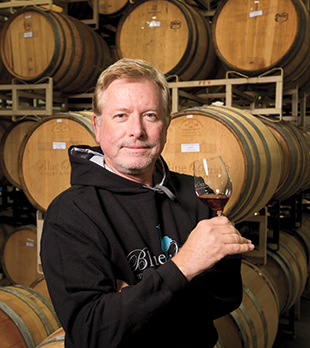
Winemaker Patrick Whitehead in the barrel room of Blue Ostritch Winery & Vineyard.
Seven miles east, Arché vineyard and winery houses its tasting room in a contemporary building overlooking the vineyards. As was the case at Blue Ostrich, a lively afternoon crowd filled tables inside and out. We sampled two dry wines, the full-bodied syrah and the crisp rosé, the latter with a label featuring Donna Howell-Sickles’ artwork. After buying a bottle of the rosé, we set off for a dinner that came highly recommended.
At Ancient Ovens, a weekend-only dining destination just a few minutes’ drive from Arché, we enjoyed an evening filled with good food and conversation. Guests come from across Texas to dine here, and the reputation for the pizzas and breads served fresh from the patio’s large, wood-burning oven extends well beyond: Owners Denis and Susan Moody say they’ve served guests from across the country. The dinners, which last about two hours, are so popular that the hundred or so seats are booked up weeks in advance.
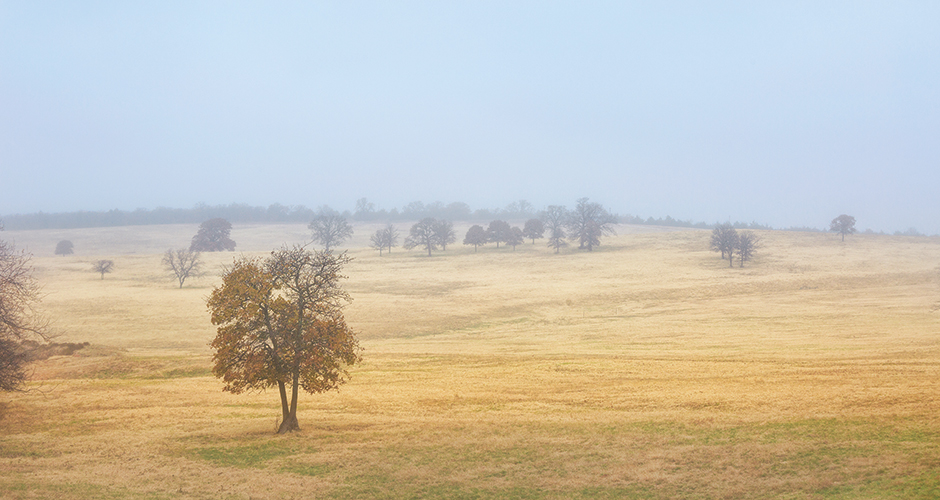
And no wonder: The open-air dining experience is casual and friendly, with community seating at tables under sprawling oak trees and the stars above. The Moodys urge guests to bring their own wine and beer (encouraging folks to buy at the local wineries) to enjoy with the baked bread creations and thin-crust pizza. We especially liked the artichoke-spinach dip and the pizza topped with tomato, mozzarella, spinach, and green olives. When the weather’s intemperate, there’s a sizable indoor space with another big stone pizza oven.
That such a great dinner and setting would await us on the trip was just another in a long line of surprises in our Red River Valley expedition.
Unwinding after a day exploring the Red River Valley, writer June Naylor discovered that apricot fried pie and Texas rosé pair well. Photographer Joel Salcido says he found the beauty of the landscape north of Saint Jo “incredible and at times surreal.”








